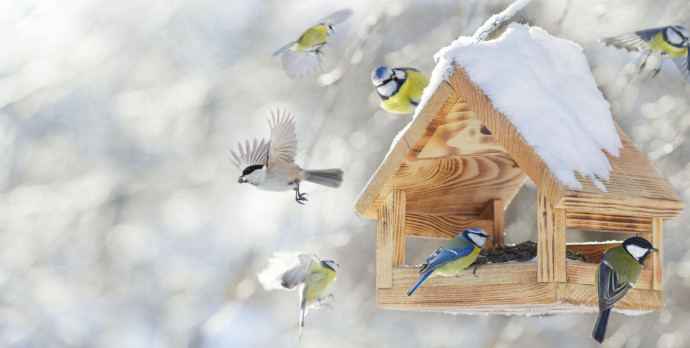Plant Trees and Shrubs to support Birds. Help out in Winter with birdseeds.

During the pandemic years, bird feeding became a hugely popular activity here in North America. Today, in the United States, over 57 million people routinely feed birds, spending more than 12 billion dollars
annually on wild bird related products. At least 5 billion of those dollars purchase various forms of wild bird food, while 960 million is spent on bird feeders, bird baths and nesting boxes. Many experts feel that feeding birds is a “recession-proof industry.”
Depending on the blend, the quality and the brand, the cost of a 5-pound sack of bird seed can range from just under $5 to almost $40 per 20 lb bag of shelled seed, no mess to cleanup. As the blends I used changed, so did the birds that visited my feeders. We began seeing fewer house sparrows, starlings
or pigeons. Instead, I was thrilled to see there were more cardinals, finches and chickadees (to name just a few) to watch.
Winter birds have adjusted to eating during the frigid winter temperatures of the woods and open meadows of Westchester and Fairfield Counties. Some species store food from bird feeders to eat later in winter, while others expand their food sources and change their diet.
Despite these incredible adaptations, winter can still be a stressful time for our favorite winter birds. We can help support winter birds by providing an assortment of native plants as well as bird feeders and seed when natural food sources may be scarce or under cover of snow and ice.
Bird feeding tips: Attract Downy Woodpeckers with suet feeders, which can also attract other woodpeckers, titmice, nuthatches, chickadees and the occasional wren, creeper and warbler! These small birds can be attracted using tube feeders with black oil sunflower seeds, mixed seed, safflower seed, or peanuts. This may also attract Pine Siskins, Purple and House Finches.
Native plant tips: Maintain a dead or dying tree, where woodpeckers can build a cavity for roosting or nesting. Plant native trees such as American Basswood, American Beech, American Elm, and Oak, as well as seed and fruit producing plants including Freshwater Cord Grass, Cock-Spur Hawthorn, or Northern Spicebush. Plant native trees, shrubs and grasses that produce seeds and nuts each fall and winter, such as American Hazelnut, American Witch-Hazel, Common Buttonbush, Smooth Arrow-Wood, White Sagebrush or Yellow Indian Grass. Consult with Peter Atkins about helping build your landscape with woody ornamental plants and trees that support wildlife.
The following is a list of the favorite seeds that will attract your favorite birds to your home this winter. Remember to keep the feeder several feet away from the window for safe flight and not confusing the bird that the passage is not open for flight. Best to use some bird glare symbols on the window that help birds realize that the glass wall is not safe.
Seeds that are great for the birds:
All-around favorite: Black-Oil Sunflower Seeds.
They contain a lot of protein and fat and their thin shells are easy to crack.
Cardinals & Blue Jays: Sunflower hearts and
chips, striped sunflower seeds, safflower seeds, peanuts, red and white millet
Mourning Doves: Safflower seeds
Robins: Sunflower hearts and chips, white millet
Chickadees: Sunflower hearts, striped sunflower
seeds, safflower seeds, white millet
Finches:
Striped sunflower seeds, safflower seeds, red and white millet, flaxseed
Hummingbirds:
Sugar water; made by combining four parts hot water to one part white
sugar, mix and let cool. Never use honey, artificial sweeteners, or red dye.